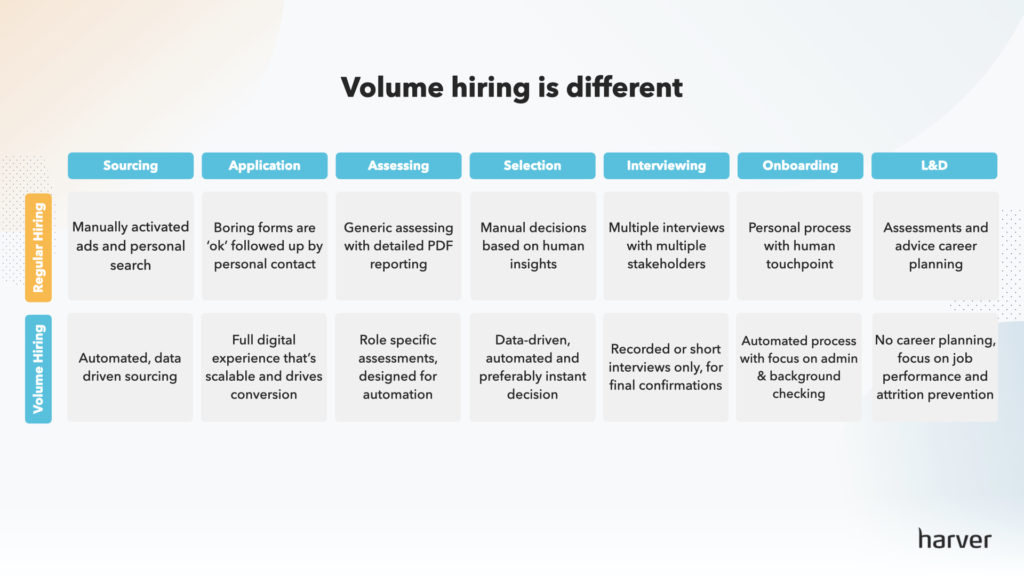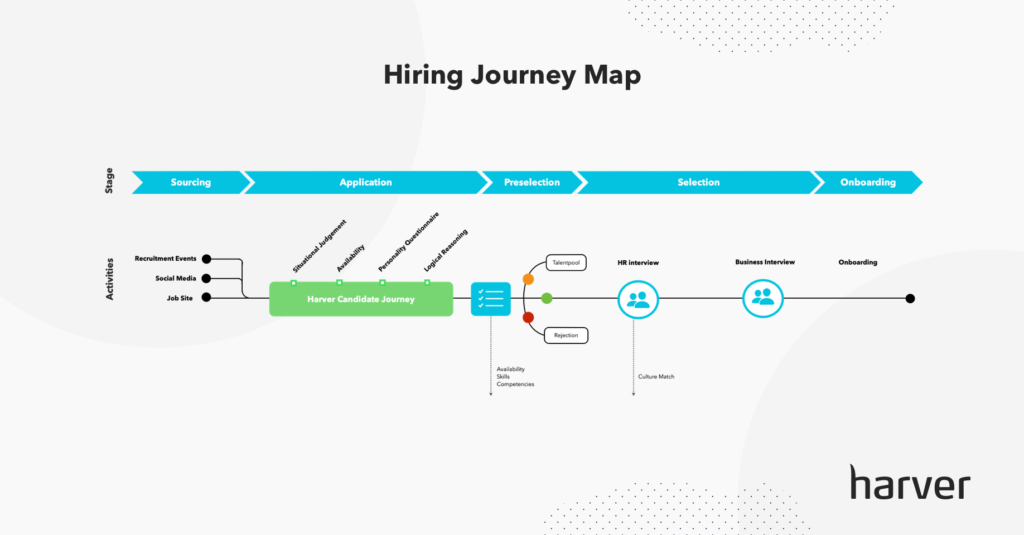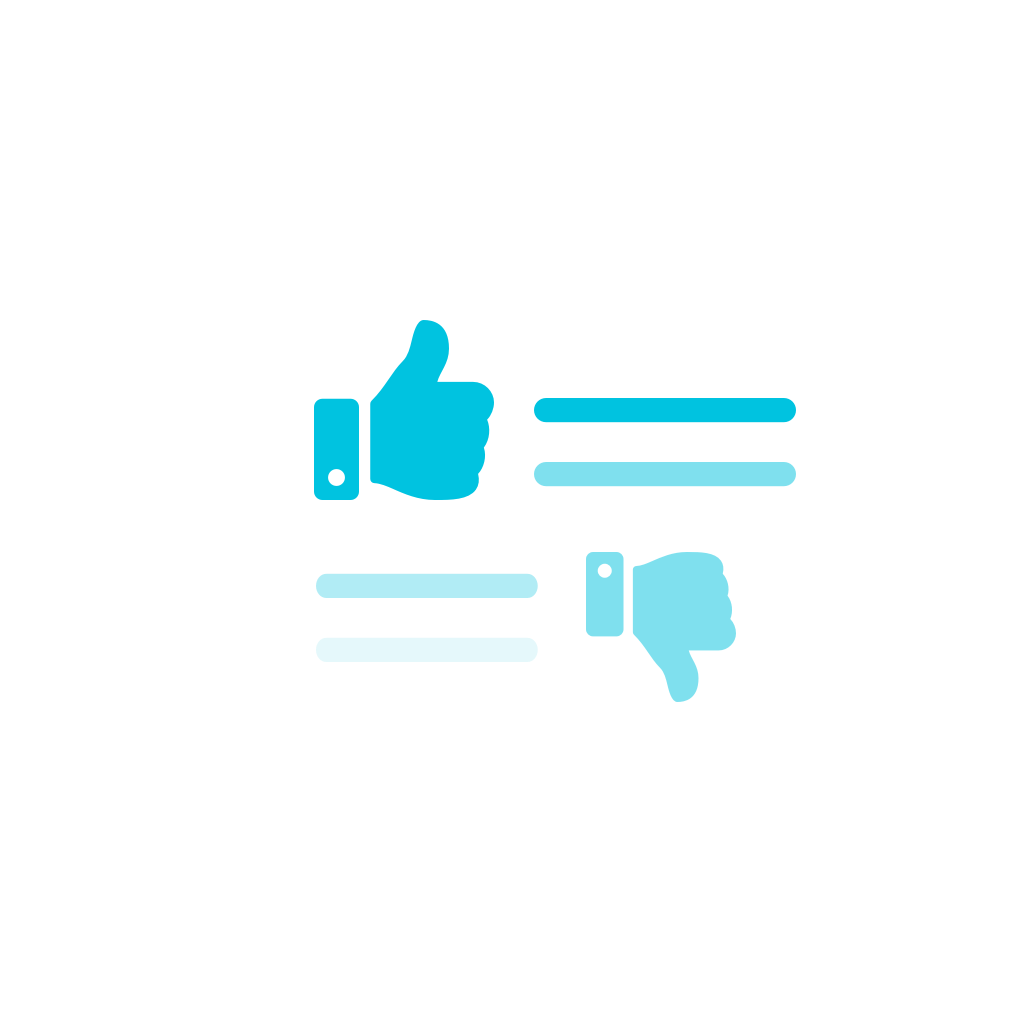Automating candidate screening is essential in volume hiring. When you’re hiring at scale, everything happens at scale – more job applicants, more work for recruiters, more time, more expense.
Every challenge is bigger and more complex, and when you’re screening thousands of candidates at a time, traditional screening methods can’t handle the pace and screening quickly becomes an overwhelming task.
On top of that, volume hiring is a never ending stream of open roles that constantly need filling. Recruiters barely have time to catch their breath let alone think about anything else, such as candidate experience, or quality of hire.
If you’re in one of these situations, a good first step towards optimizing your volume hiring strategy, process and hiring tech stack is to know what the different screening methods out there are, and how to move from an outdated one to an effective screening process. This article will show you how.
What’s in?
Like what you see?
Don’t miss out. Subscribe to our monthly digest to get the latest TA and TM resources delivered right to your inbox.
What is candidate screening?
Candidate screening is the process of determining whether a candidate is qualified to progress through your application process. The goal of candidate screening is to efficiently sort through the hundreds, if not thousands, of applicants to identify the best candidates for your roles.
Candidate screening is a normal part of the hiring process. It affords recruiters the opportunity to create a short list of quality candidates who have the potential to do well in the open position.
Screening is usually based on the candidate’s skills, their experience and their expertise. Candidate screening can take place at any stage of the application process i.e. resume sifting, skills assessments, interviews, even a probationary employment period.
Why candidate screening in volume hiring is different
We’ve found time and again with our clients that their volume hiring issues largely lie with their outdated candidate screening methods.
Depending on the maturity of their hiring, they might be using manual procedures, a combination of spreadsheets and manual procedures, or a tech stack that was put together over a long period of time, and doesn’t help them streamline the process or the application experience.
Trying to use traditional screening methods when volume hiring is like trying to fit a round peg into a square hole. It’s inefficient, leads to ineffective hiring processes, an increased workload for recruiters, and a confusing experience for candidates.
Not to mention it negatively impacts everything downstream – quality of hire, retention rates, attrition rates, employee experience, customer satisfaction etc. When you fail to screen candidates effectively, it can have a detrimental impact organization wide.
And that’s because volume hiring is different.

In regular recruitment, recruiters usually only carry out an initial screening, typically manually, soon after sourcing candidates.
They apply filters to applications, sift resumes and read cover letters in person. They manually check each applicant’s education history, review prior work experience, and carry out a background review. They ask successful applicants to do a series of out of the box assessments that assess them only for the skills the role requires. They then make a bias-infused hiring decision based on gut instinct.
When you’re volume hiring you don’t have the luxury of time to do any of that.
You’re routinely dealing with hundreds, if not thousands, of applications, constantly. Applicants have to be screened in a fast, efficient, unbiased manner to keep up with demand.
This process needs to happen automatically because if you’re trying to apply regular recruitment screening processes when volume hiring, you’ll likely take too long and lose the candidate(s).
Plus, in entry level roles that require volume hiring, applicants expect a fast, efficient process. They care more about a pay check and job security than where their career is going. Meaning the employer who offers them employment fastest, typically wins the candidate. The longer you take to screen, the lower the quality of hire you’ll end up with.
Candidate screening methods
There are multiple ways to screen candidates, from manual to digital solutions. We’ve outlined 7 ways below:
1. Screening resumes
Screening candidates based on their resumes is one of the more traditional ways to determine if a candidate meets your criteria or not. Resume screening involves scanning through a candidate’s resume to find out more about their education, work history, any certifications, key skills, etc.
2. Screening cover letters
A cover letter gives applicants the opportunity to expand further on their application.
For example, if there are any elements of their resume that need more explanation, or any gaps in employment that need explaining. It can also be a place for them to express their motivation for the role, highlight their strengths, their areas of expertise, and their future career aspirations.
Cover letters also give recruiters an opportunity to assess how well an applicant can express themselves, including their communication and writing skills.
3. Screening video applications
A video application is an alternative way to apply for a job. It’s a 1-2 minute video where the applicant explains who they are and why they’re a good fit for the role. If you need applicants to demonstrate particular skills i.e. language skills, this is a good way of seeing what the applicant is capable of before screening them.
4. Phone screen
The phone screen is typically the next step after the resume sift. This is where the most suitable candidates are requested to take part in a short phone interview. Recruiters cross check any necessary information or gather information they don’t already have, such as where the applicant is located or what their availability is.
5. Pre-employment assessments
These assess applicants for the necessary skills, characteristics and traits required to be a good job fit. There are many different pre-employment assessments available, both out of the box and bespoke to your organization.
The most common types of pre-employment assessments to screen candidates include personality questionnaires, skills tests, culture fit and situational judgment tests.
6. In person or video interview
The interview screen is usually the last screening opportunity before making a hiring decision. The in person or virtual interview is where applicants are sold the role as much as they are assessed for their suitability for it.
Candidates are typically asked a series of questions to give recruiters a more rounded picture of them, from how effective a communicator they are to their general demeanor and attitude.
A live video interview allows recruiters to screen more applicants more quickly as they don’t have to arrange on-site interviews. Simply invite applicants for a video interview, these can be either synchronous – a two way live conversation, or asynchronous – where the candidate records their answers to a set of pre-recorded questions for recruiters to review at a later date.

7. Background checks and reference checks
The final candidate screening method is running background checks and reference checks. Before recruiters make a hiring decision, they need to check that the candidate is who they say they are and that they have no skeletons hiding in their closet.
Our partners at Checkr have covered this topic in the e-book below.
How to upgrade your candidate screening process
For our customers, before they start redesigning any stage of their hiring journey, we recommend they get the full picture of where they are currently by creating a hiring journey map.

This is a visual representation of every stage your candidates go through on their hiring journey with you. It provides clear oversight of your full recruitment process, allowing you to experience what the candidate experiences, and showing you how your current tech stack holds up, and what the bottlenecks and gaps are.
Mapping the hiring journey also helps highlight what data your recruitment team and hiring managers need to pay attention to and collect during each step of your recruitment process, including during the screening procedure.
Once you have a clear journey map in place, you can see, at a glance, which steps of the process can be optimized and automated, including screening.
By moving away from manual, time-consuming candidate screening to a streamlined, automated, digital-first screening process, you not only improve your applicant screening, but you save money, time and improve quality of hire in the long run.
If you’d like to see how Haver can transform your hiring process,
book a demo here!
Automated pre-employment assessments
Replace screening phone calls with AI-powered, scientifically-validated pre employment assessments that accurately assess a candidate’s skills and traits through situational judgment tests. These help you identify candidates with the best skills for the role. Simultaneously, they provide a realistic job preview, identical for each candidate.
If the applicant doesn’t pass the assessments, they don’t progress through your hiring process. If the applicant doesn’t like what they see, they can remove themselves from your hiring process. It’s a win-win all around, and in volume hiring, it makes a huge difference.
Allied Global, for example, one of our customers in the contact center space, have replaced their manual screening and recruiting process with Harver’s end-to-end volume hiring solution, increasing their quality of hire and decreasing attrition. They’ve shared their experience in the webinar below.
Video interviewing tool
Use a video interviewing tool and allow applicants to record a video application instead of submitting a resume. Past experience is no indication of future performance, so rather than assess someone based on what they’ve done previously, sound them out in a 1-2 minute video.
Ask candidates to answer a series of short, predetermined interview questions. Doing this allows you to reduce bias in the process too by ensuring all applicants are asked the same screening interview questions, plus you can screen candidates blind too.
We’ve covered this topic extensively in the articles below.
Interview scheduling
If you schedule interviews manually, you can automate that as well, streamlining the process even further. In high volume hiring, it’s not uncommon for successful candidates to ghost recruiters and not show up for their interview.
Automatically scheduling interviews for successful applicants frees up recruiters to focus on the more important tasks i.e. the actual interviews and making the hiring decision. Even better, put the power in candidates hands and allow them to self schedule an interview with a recruiter at a time to suit them.
Next steps
With so many different stages of the hiring process involved in screening candidates, automating as many of them as possible will not only save you time and money, but it will yield better quality candidates and deliver a better candidate experience.
If you’d like to see how the Harver platform can automate your candidate screening, you can book a demo below.









